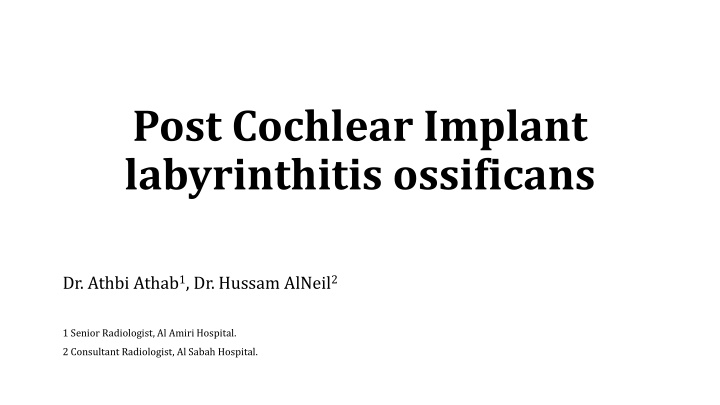
Cochlear Implant-Induced Labyrinthitis Ossificans: Case Study & Imaging Findings
Explore a case study on cochlear implant-induced labyrinthitis ossificans in a 3-month-old patient with bilateral sensorineural hearing loss. The article details pre-implant imaging, surgical success, subsequent hearing loss, and HRCT findings indicating left-sided labyrinthitis ossificans post-cochlear implantation.
Download Presentation

Please find below an Image/Link to download the presentation.
The content on the website is provided AS IS for your information and personal use only. It may not be sold, licensed, or shared on other websites without obtaining consent from the author. If you encounter any issues during the download, it is possible that the publisher has removed the file from their server.
You are allowed to download the files provided on this website for personal or commercial use, subject to the condition that they are used lawfully. All files are the property of their respective owners.
The content on the website is provided AS IS for your information and personal use only. It may not be sold, licensed, or shared on other websites without obtaining consent from the author.
E N D
Presentation Transcript
Post Cochlear Implant labyrinthitis ossificans Dr. Athbi Athab1, Dr. Hussam AlNeil2 1 Senior Radiologist, Al Amiri Hospital. 2 Consultant Radiologist, Al Sabah Hospital.
3 months old patient presented with bilateral sensorineural hearing loss since birth. Family history was negative for hearing loss and the genetic testing was unremarkable. Patient was planned for cochlear implant. Pre-implantation HR CT of the petrous bone revealed normal inner structures and cochlear nerves; mild opacification of both mastoid air cells (more on the right) and the hypotympanum of the right middle ear cleft were observed on both sides with prominent nasopharyngeal adenoid. Ear infection was treated by proper antibiotic and after resolution of the inflammation, the patient underwent bilateral cochlear implants. The surgery was successful, and the patient showed improved hearing on audiologic testing. 2 years later, parents noticed decreased hearing of their child. Audiologic testing revealed left sided sensorineural hearing loss. Patient was referred for HRCT of the petrous temporal bone to assess for implant integrity and position. CT revealed adequately positioned electrode with no kink, interruption or fold over on either sides. Opacification of the mastoidectomy bed and middle ear was observed on both sides denoting infection. Dense ossification along the left membranous labyrinth, including cochlea lumen, vestibule and semicircular canals, was noted. Findings were in keeping with left sided labyrinthitis ossificans (LO) as a complication of the cochlear implant surgery.
Pre choclear implant HRCT left petrous bone; mild partial opacification of the mastoid air cell (blue arrow) and the middle ear cleft (green arrow). Normal appearance of the cochlea (orange arrowhead), vestibule (black arrow), semicircular canals (Pink arrow)
Image (A-D) consecutive axial HRCT images of the left petrous bone. Image (A): High-density bone deposition within the cochlear turns(Blue arrow). Intact cochlear implant electrode(Dashed Blue arrow). Image (B): opacification of the left mastoidectomy operative bed (pink arrows) and the middle ear cleft (green arrow). Image (C): High-density bone deposition within the cochlear turns(blue arrows), vestibule (black arrow) and the SCCC (curved blue arrow). Image (D): High-density bone deposition of the basal turn of the cochlea(Thin orange arrow). The electrode is seen intact and reaching the apical turn of the cochlea (Thick orange arrow). (B) (A) (1) Image (1) coronal reconstructed image CT of the left petrous bone: Dense bony ossification involving the cochlea (blue arrow), partial opacification of the middle ear cleft (Green arrow). (C) (D)
Literature references Alsalhi, A., Alshawi, Y. A., Alsalhi, H. S., & Hagr, A. (2022). Cochlear implant induced labyrinthine ossificans in Mondini malformation: a case series. Cureus. https://doi.org/10.7759/cureus.32648 Swartz, J. D., Mandell, D. M., Faerber, E. N., Popky, G. L., Ardito, J. M., Steinberg, S. B., & Rojer, C. L. (1985). Labyrinthine ossification: etiologies and CT findings. Radiology, 157(2), 395 398. https://doi.org/10.1148/radiology.157.2.3931172 Buch, K., Baylosis, B., Fujita, A., Qureshi, M., Takumi, K., Weber, P., & Sakai, O. (2019). Etiology-Specific Mineralization Patterns in Patients with Labyrinthitis Ossificans. American Journal of Neuroradiology. https://doi.org/10.3174/ajnr.a5985 Yousem, D. M. (2014). Head and Neck Imaging: Case Review series E-Book: Head and Neck Imaging: Case Review Series E- Book. Elsevier Health Sciences.
